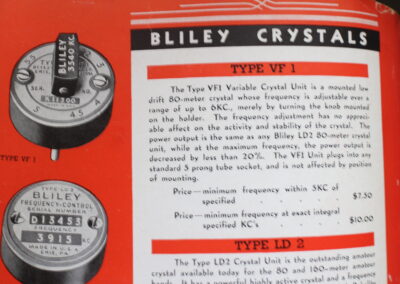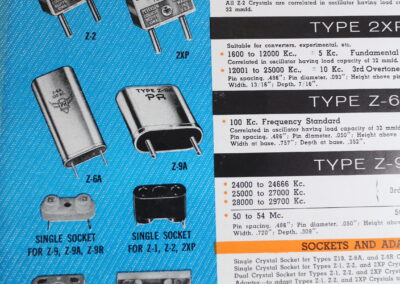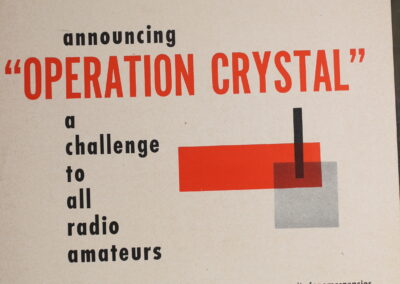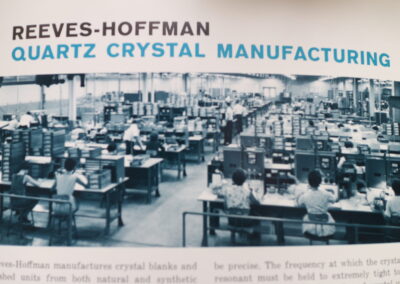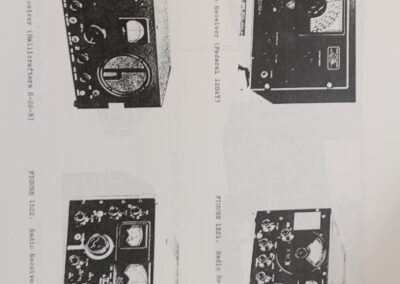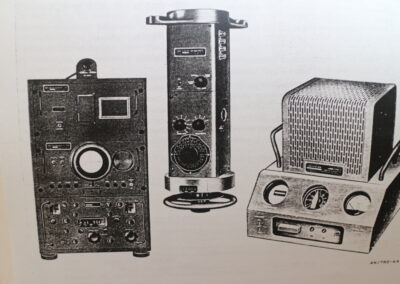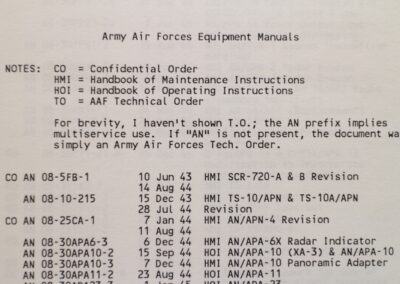


Quartz Radio Crystals, Part II

Quartz for Radio, Part II
As the second world war loomed, it was clear to many that science and technology would play key roles. Precise frequency control would become fundamental to what Dr. R. V Jones termed ‘The Wizard War.” (read the book!–it is not to be mssed!).
Other than through frequency synthesis some 20+ years later, the only reliable method of obtaining and retaining frequency stability at the start of WWII was through cutting, polishing (lapping) and finishing extremely precise slices of quartz.

Axes and Reference Directions
An orthogonal coordinate system was developed for precisely selecting crystals for broad frequency ranges and sopecific frequencies within those ranges. For instance a so-called “X-cut” crystal was useable in radio at frequencies beween 40 and 350khz, As you may well imagine, under the pressure of wartime needs, research quickly identified many other cuts along many other axes that produced crystals that could resonate at precise and extremely useful frequencies.
As the war heated up, the US military identified a need for MILLIONS of crystals for its’ radios. Radio designs chosen for production were often chose on the basis of the need the radio design would create for more crystals. And yet, the work required was so precise that it resisted conventional attempts at ‘Henry Ford-style” automation.
Crystal “holders” grew many and varied. Early holders had to be designed to take high current imposed by then-popular oscillator designs.Even with good holder designs, many valuable crystals were lost–cracked when they overheated.
The brief gallery of images below reviews post-WWII crystal holder designs and other engineering wizardry that surrounded the humble quartz crystal.
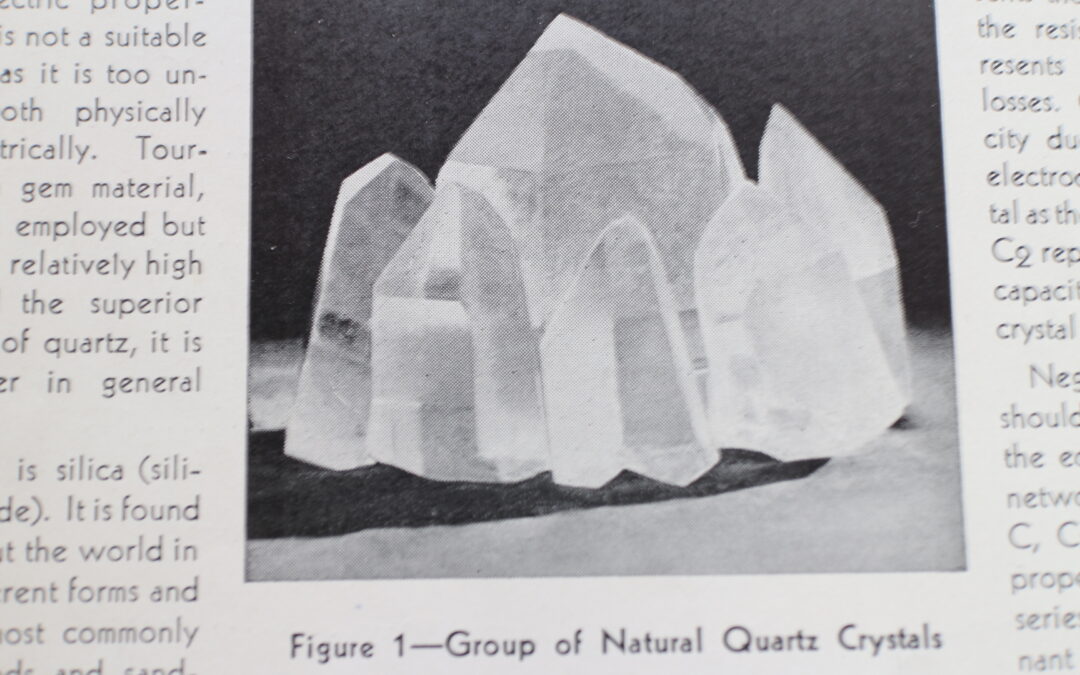
The Magic Crystal That Saved Radio
At the end of “The Great War”, the new technology of radio was problematic at best. The problems were many and the solutions few. The rectifying characteristic of lead sulfide (galena) had been uncovered long before (in 1881). Pressure on the crystal was key–and so the effect was named “piezo-electric” (which literally means “pressure electricity”).But it wasn’t until after the Great War that patents started beig registered for “crystal-controlled” radio frequency circuits.
Early experimenters and amateurs discovered that a point contact “cats whisker” could be moved around the surface of the galena until a rectifier junction (unknown in those terms at the time) was formed. Rectification allowed radio signals to be detected. Surround the cats whisker with the right coils, capactors and resistors, with a crystal headphone opposite he antenna connection and you had a crystal radio that could detect signals and separate them from others (in a pretty limited way).
By then, Broadcast Radio had sprung to life–with every station at or near the same frequency! A means was needed to accurately put a radio transitter on frequency and keep it there. Researchers discovered that quartz, when cut in specific ways could be made to resonate in almsot exactly one and only one frequency (yes, I’m leaving out considerations of harmonics for now). Commercial radio station WEAF became the first crystal-controlled broeadcast station in 1926.
Cutting crystals by hand was labor-intensive with a huge failure rate. But the need was low between the wars. Most transmitters were MOPA designs–Master Oscillator–Power Amplifier that used tuned circuits, not crystals to establish and hold the transmitting frequency. Most receivers for broadcast use just didn’t need the accuracy that cystals delivered.
The limited needs of industry and ham radio in the depression-wracked 1930’s were served by a few garage-shop entrepreneurs including Bliley, Valpey, Petersen (after 1934) and James Knights. Production-line methods were not in use and all crystals were hand-cut, hand-polished and laboriously tested.
Those pesky ham radio operators and a small event called the second world war changed all that. Details in Part II. But please browse the PARS library of cystal history photos below!

Radio History Found In Railroad Union Archives

Radio History Found In Railroad Union Archives
By
Frank J Lotito K3DZ
It continues to amaze me where one can find articles related to the history of electronics and radio! I am
talking about original publications, not the ramblings of some author (like me) who 50+ years after the
fact puts his own spin on history!
One particular set of publications where the original history of radio and electronics can be found is the
magazine that was published by the “The Brotherhood of Locomotive Firemen and Engineers fn(1) ,” here
after referred to as the “B of LF&E.” I understand that it was quite common way-back-when for fraternal
and labor unions to publish magazines containing articles not only highlighting current events related to
their mission, but also containing articles pertaining to other interests of the members. One of the “other
interests” of the members was “radio” and its allied fields. Most definitely, beyond a doubt, radio during
the 1920’s through the WW2 era was experiencing its “Golden Era!” Everybody wanted in, except for
my maternal grandmother’s commandment of “no radio on Sundays! “Nyet!” followed by a stern look.
In my personal library I happen to have excerpts from a number of the B of LF&E organization’s
magazine titled “Radio Department.” The excerpts range in date from the mid-1920’s through the early
1930’s. The Table below lists, in summary, my holdings. If you are interested, this magazine might be
found in the library archives of footnote 2. The Cornel University archive may be a little difficult to
access. The Radio Department articles are primarily “how to build it yourself.” I can also be enticed to e-
mail you a scanned pdf of an article or two.
Where did I get these excerpts? A photocopy I made years ago from a friend and mentor’s [W3RLX(sk)]
personal semi-organized collection of memorabilia. He obtained this material as a youngster growing up
in the pre-WW2 Turtle Creek, PA area. My friend used to comment on how difficult and expensive it
was to find stuff (material for building and literature) on radio and electronics during the depression era.
To feed his growing interest in radio and electronics he would always have an eye out for radio and
electronics related materials. As I dimly recall, my friend obtained these B of LF&E publications from a
neighbor who belonged to that union.
So, bottom line, while snooping around at flea markets, yard sales, estate sales, charity shops such as
Goodwill/St Vincent dePaul/Salvation Army, keep an eye peeled for 1900’s through maybe 1970’s era
publications other than those obviously devoted to electronics and radio. You never know what you
might find! After all, part of the PARS mission is to preserve the written history of radio and its allied
fields. You never know, one of these literature finds, used as an adjunct, may push your entry into “Best
Of Show” during a PARS event! And, that material may be the God’s honest truth, and not the ramblings
of a self-ordained historian brought up during the post-WW2 era’s “land of plenty!”
[At this point in his original, Frank included a table of a superb set of references to radio articles in the railroad magazine called: Summary of Holdings at K3DZ for the “Radio Department” Section of the Magazine Published by the B of LF&E. Unfortunately we have no way to reproduce the table on the web site and retain its’ formatting. If you want to see the table, please email the webmaster for an email copy of it.]
Footnotes:
fn(1) from Wikipedia: The Brotherhood of Locomotive Firemen and Enginemen (B of LF&E) was a North American railroad fraternal benefit society and trade union in the 19th and 20th centuries. The organization began in 1873 as the Brotherhood of Locomotive Firemen (B of LF), a mutual benefit society for workers employed as firemen for steam locomotives, before expanding its name in 1907 in acknowledgement that many of its members had been promoted to the job of railroad engineer. Gradually taking on the functions of a trade union over time, in 1969 the B of LF&E merged with three other railway labor organizations to form the United Transportation Union. In 1969, the union merged with the Order of Railway Conductors and Brakemen, the Brotherhood of Railroad Trainmen and the Switchmen’s Union of North America to form the United Transportation Union.
fn(2) B of LF&E Archive Sources:
https://catalog.hathitrust.org/Record/000675974
https://libraries.psu.edu/findingaids/1453.htm
https://rmc.library.cornell.edu/EAD/htmldocs/KCL05141.html
fn(3): Originally published in the “Radio News,” copy write:
(a) December 1929
(b) November 1930
(c) December 1930
(d) March 1931
(e) April 1931
fn(4) GE Company, Schenectady, NY


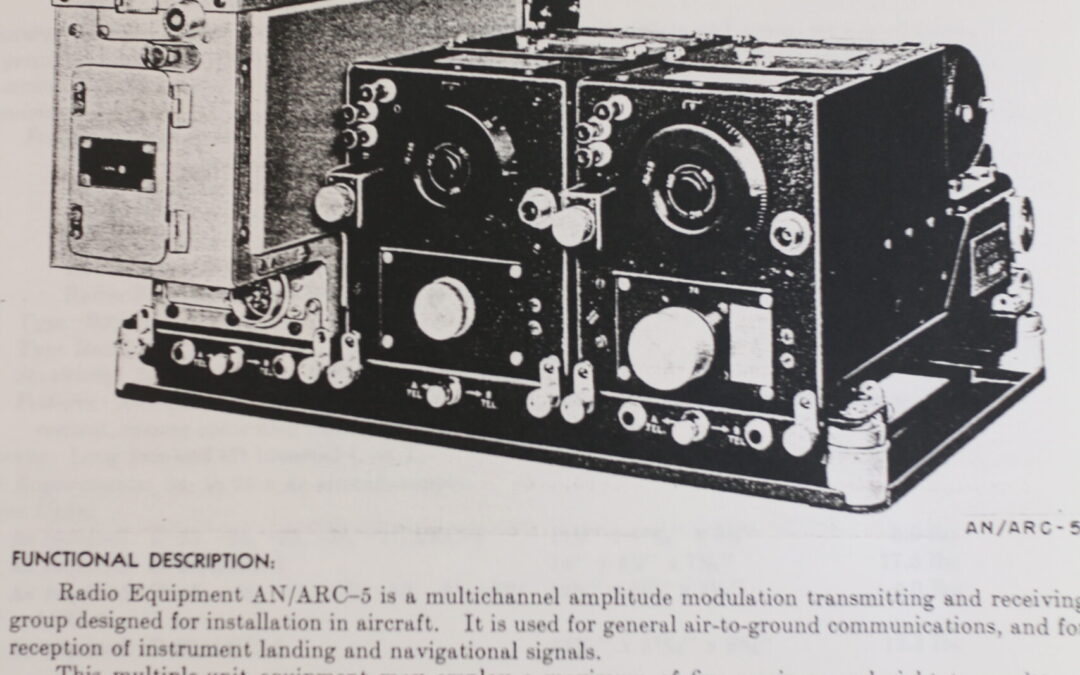
Top Secret! Collecting Military Radios, Part 2
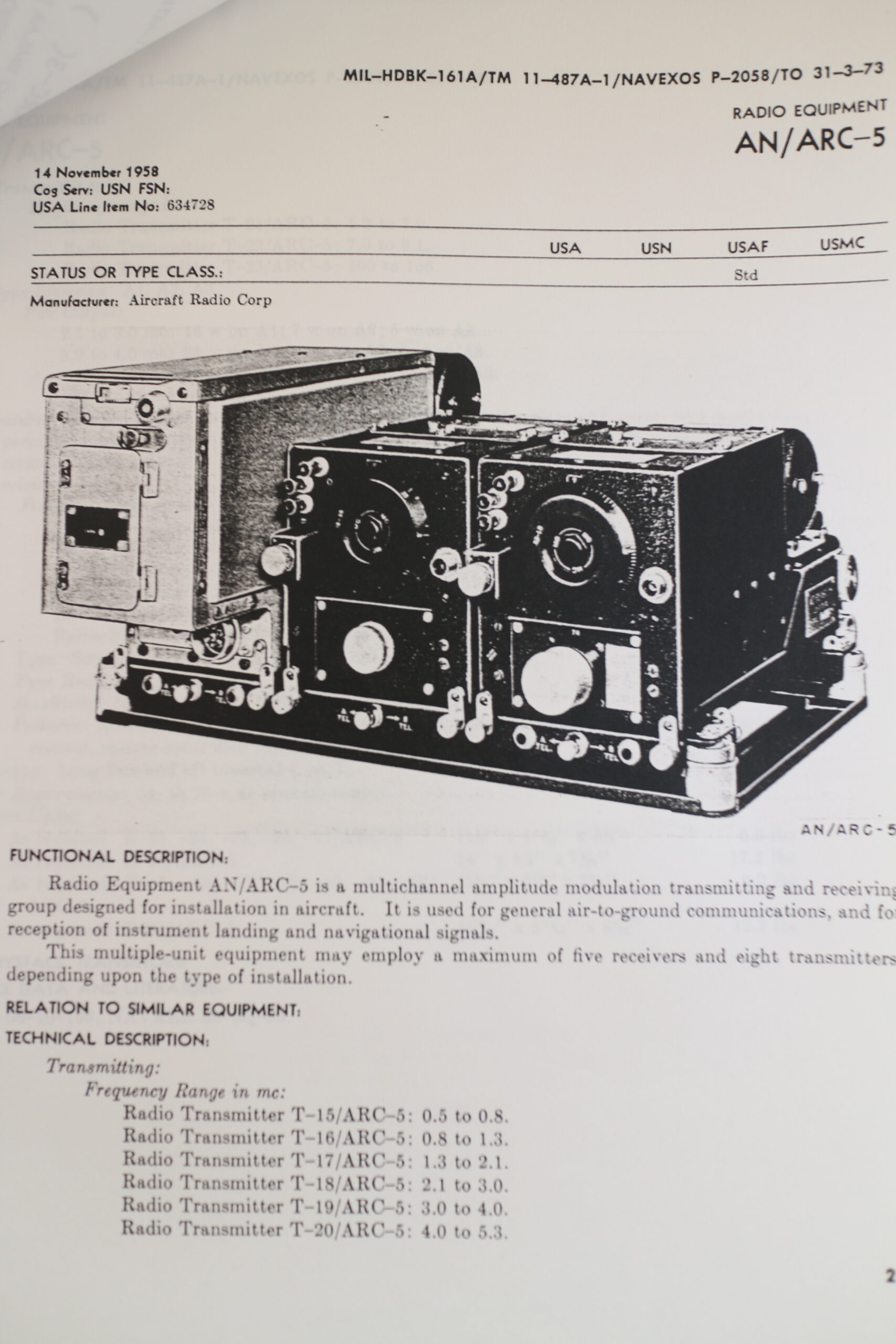
The Guides You Need To Understand What's Available
In Part 1 I covered the indexes to military publications that were compiled by Ray Mote. The US military had (and has) a series of complex nomenclature systems that vary from one branch of the service to the next, and within any one service, from one intended usage to the next. So was the manual you are looking for intended to be used to repair the radio? Or was it intended to be used by instructors at specific schools to teach many operators how to use the set? Ray categorized the original military radio manuals within the complex framework that the service used–kind of like the Dewey Decimal System for military radio manuals.
OK, great. Now, thanks to Ray Mote, you’ve got indexes to the manuals you need. But which manuals out of the THOUSANDS published by the services will be the most useful to you as a COLLECTOR? That is the question I am trying to answer in this PART 2 post.
The undisputed Rosetta Stone for WWII radio collectors is TM 11-487 “Directory Of U. S. Army Signal Equipments”. This huge, multi-thousand page document, is divided up into sections that group similarly-used equipment together. So I am just going to pick a section to use as an example. My example is TM 11-487D “Radio Direction Finding Equipment.” Pictures in the gallery below show sample pages from the March, 1958 version of this document.
Yes, sorry to break it to you, but 11-487 was constantly being updated, with different sections updated and published at different times. The entire document was never updated and republished as a unit, to the best of my knowledge. Original copies of any one section of 11-487 sell for hundreds of dollars JUST FOR ONE SECTION! So a complete original from the immediate post-war era would have to be worth $2-$3,000–or more. To be honest, I doubt that even the Smithsonian has a complete 11-487 with all the changes and updates.
Luckily for you, the chapter you want as your road map to military radio collecting, is most probably chapter 14 of 11-487 and copies of that Chapter are floating around at reasonable prices. Picture quality is what is important. Some of these have been copied so many times that the radio photos are essentially useless. I have attached some pix from my chapter 14 copy in the gallery below so you can see what I mean.
Some sections of chapter 14 are irreplaceable. Paragraph 1409 shows an inter-operability chart that illustrates which radios can talk to which other radios on a specific range of frequencies. So all those war movies where you see the guy on the handi-talkie talking to the guy on the SCR-300 backpack set are total BS. The handi-talkie was an AM radio. The SCR-300 was FM! And you say that you’ve never seen an AN/GRR-3 radio? Of course you have–AN/GRR-3 was one of several military nomenclature IDs assigned to the Hallicrafters SX-28! These are the kinds of questions that are answered in the thousands by Chapter 14 of TM 11-487.
Let me mention just one other great original military reference and I’ll stop there. The book was published by the Dept of Defense in an attempt to combine and standardize the separate reference publications of the Army, Navy and Air Force. It carries nomenclature ID MIL-HBK-161A, I think the original version of this document was released and is dated March, 1964. Most unfortunately, by that date, all or most of the great WWII collector sets had been replaced by more modern radios. Since they had been stricken from the services’ inventories, they do not appear in 161A. MIL-HBK-161A is where you will need to go for all your radios with tags that start “AN/ARC…” etc. etc. So you would find your ART-13 transmitter listed here, but not in 11-487. (I think? Who knows for sure? I never saw a document that claimed to be the FINAL issue of 11-487. Anyway, a few pix from 161A close out the gallery below.
Military radio collecting is complex. But the rewards are unique–literally history in the flesh. So don’t be put off by the complexity.

Top Secret! Collecting Military Radios Pt. 1
The most imortant skill you need to collect military radios is the ability to speak the lingo. “SCR”? “BC”? “TM?” Who or what was “COL”? The military had a huge nomenclature system that need not be mastered. But if you want to find parts for your “ATD” then it might help to know that it is a transmitter! At the peak of the military surplus collecting frenzy of the 1980’s, there were many great guys involved in the hobby who wanted to help preserve their collections and even donate time to making sure the Smithsonian collection was in good order.
One of the big Smithsonian radio collecor/restorers was Mike Hanz. Among other things, he did significant work on the radio section of the Enola Gay. Another guy, whose contribution was more subtle but no less important was Ray Mote, W6RIC (now SK). Ray literally wrote the book on military radio nomenclature. In a huge labor of LOVE, he compiled the rosetta stone of WWII-era military radio manuals and terminology.
I just did a search on the web and was disgusted to find hat Ray’s work does not seem to have survived intact anywhere. Bits and pieces of it are scattered over many web sites, mostly with Ray’s name removed (SHAME!). Part of this was Ray’s fault. As he completed each section of his work, he simply released it on the internet and interested webmasters could catalog it on their site or not, as they chose. Most of Ray’s stuff could be found on THEPORCH.COM. THEPORCH still exists and still has the archives of the BOATANCHORS site that it once hosted. If you want the files that Ray created, go to THEPORCH.COM, become a member of BOATANCHORS and get access to the archives. From there, you will have plenty to do for the next several months!
I printed a lot of Ray’s work out in 1995 and have kept the printouts ever since to use as a reference. Copies of the front page of each section I have are shown in the gallery below. If you have not seen these references created by Ray Mote, then you MUST become a member of BOATANCHORS and go get copies of this stuff.
In the second part of this post, I will discuss official US military references that you will find useful.










